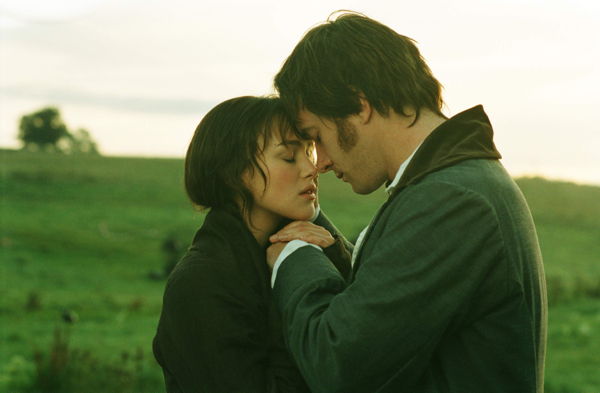Movie review by Greg Carlson
Considering the ever-growing number of Jane Austen fans populating several generations, it is somewhat surprising to note that Joe Walsh’s 2005 adaptation of “Pride & Prejudice” marks only the second full-fledged big screen telling of the classic tale, following sixty-five years after the Greer Garson/Laurence Olivier version produced by MGM. Obviously, this discounts “loose” incarnations like the utterly awful “Bride & Prejudice” and the modern Mormon spin called “Pride and Prejudice: A Latter-Day Comedy.” Many Austen-philes adore the various small screen miniseries, particularly the 1995 BBC version starring Jennifer Ehle and Colin Firth. That said, the new theatrical release is a solid contender for the best of the best, a sprightly and completely entertaining movie that should please newcomers as well as those familiar with the variety of earlier entries.
Initially, one might think that Keira Knightley would be unable to capture the liveliness and self-possession of Elizabeth Bennett, but the 20-year-old actress delivers a beautifully detailed performance that marks the finest of her short career. It is certainly a star-making turn, and Knightley negotiates the range of Elizabeth’s emotions with clarity and depth. Opposite seasoned vets like Judi Dench, Donald Sutherland and Brenda Blethyn, Knightley glows, and her scenes with Matthew Macfayden (as Darcy) often threaten to burst into flame.
Screenwriter Deborah Moggach streamlines the action of the novel to focus almost exclusively on Elizabeth, but virtually all of the essential moments appear intact. Despite tweaks made to clergyman Collins (Tom Hollander) and bachelor Bingley (Simon Woods), both of whom are purposed for comic effect, the central narrative thread chugs along while several subplots are appropriately juggled. As eldest Bennett daughter Jane, Rosamund Pike delivers a stirring and tender performance. Blethyn occasionally threatens to go over the top as Mrs. Bennett, but Sutherland’s calm patriarch balances her character’s transparent single-mindedness.
No “Pride & Prejudice” is going to work without proper chemistry between Elizabeth and Darcy, and Macfayden hits just the right note of standoffish guardedness. Some will argue that his Darcy remains too stiff for this take, which thrives on its modern airs, but many more will swoon during key scenes, especially Darcy’s initial proposal to Elizabeth. The hot and cold relationship of Darcy and Elizabeth presents a significant challenge to actors (not to mention screenwriters and directors), and Knightley and Macfayden, closer in age to the characters they are playing than many of the performers in other versions, make a fresh pair.
Director Walsh, a youngster himself, handles the picture with panache. Several set-pieces, including a lavish ball held at the Bingley residence, boast elaborate cinematic choreography, and Walsh spins us through the various rooms and into the social machinery of the furious matchmaking with ease. The film’s pacing and rhythm are rarely off, even with the sizable number of misunderstandings and miscommunications that form the heart of the tale’s two titular nouns. As Lady Catherine, Judi Dench’s brief but sharp scenes drive home some of the emotions that attend Elizabeth’s understanding of the often cruel class system that favors the very wealthy. Additionally, the costumes and production design are a treat for the eye, and the opulence of the locations ideally suits the terrific dialogue. As a result, this “Pride & Prejudice” has much to admire, and much to recommend it.
